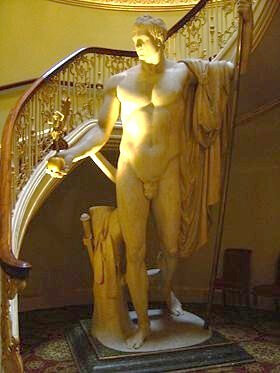Apsley House, also known as Number One London, is one of the most iconic buildings in London. This grand neoclassical mansion is located in Hyde Park Corner and was built in the 18th century. It was the London residence of the first Duke of Wellington, who was one of the most important military commanders and statesmen in British history. The architectural and cultural history of Apsley House is intertwined with the life and legacy of the Duke of Wellington and the broader history of the British Empire.
The construction of Apsley House began in 1771, when it was commissioned by Sir Robert Adam, one of the most renowned architects of the time. The building was originally intended to be a luxurious townhouse for Lord Chancellor Bathurst, but he never lived in it, and it was eventually sold to the Duke of Wellington in 1807. The Duke made several modifications to the building, including the addition of a grand staircase and a ballroom, which made it one of the most impressive private residences in London.
The neoclassical design of Apsley House is characterized by its symmetry and grandeur. The façade of the building features six Corinthian columns, which support a pediment with a sculpture of four horses. The interior of the house is equally impressive, with ornate plasterwork, marble floors, and a collection of fine art and furnishings. One of the most notable features of the house is the Waterloo Gallery, which was designed to display the Duke’s collection of paintings and sculptures commemorating his victory at the Battle of Waterloo in 1815.

Apsley House is not only a remarkable example of neoclassical architecture, but it also has significant cultural and historical value. The house was a hub of social and political activity during the 19th century, and it hosted many prominent figures of the time, including members of the royal family, politicians, and foreign dignitaries. The Duke of Wellington himself was a central figure in British politics and society, and his military achievements made him one of the most popular figures of his time. His defeat of Napoleon at the Battle of Waterloo in 1815 was a defining moment in European history and cemented his reputation as a national hero.
The cultural legacy of Apsley House and the Duke of Wellington is reflected in the house’s impressive collection of art and artifacts. The Waterloo Gallery contains a number of paintings and sculptures that celebrate the Duke’s military victories, including works by artists such as Rubens and Canova. The house also contains a collection of silver and porcelain, as well as personal items belonging to the Duke, such as his sword, boots, and campaign bed. The collection is a testament to the Duke’s importance as a military leader and statesman, as well as his personal taste and interests.

Today, Apsley House is a popular tourist attraction and museum. Visitors can take a tour of the house and see the Duke of Wellington’s collection of art and artifacts, as well as learn more about his life and legacy. The house is also an important landmark in the history of London and the British Empire, and it serves as a reminder of the cultural and architectural achievements of the Neoclassical era.
Apsley House is a remarkable example of Neoclassical architecture and an important cultural and historical landmark in London. The house’s association with the Duke of Wellington and his military and political achievements makes it a significant part of British history. Its impressive collection of art and artifacts is a testament to the Duke’s personal taste and interests, as well as his role in shaping the cultural legacy of the British Empire. Whether you are interested in architecture, history, or art, a visit to Apsley House is a must for anyone visiting London.
Visiting Information
If you are interested in visiting Apsley House, it is open to the public from Wednesday to Sunday, 11 am to 5 pm. The house offers guided tours that last approximately one hour and include access to the Waterloo Gallery and other rooms in the house. Tickets can be purchased online or in person, and there are discounts available for children, students, and seniors. A visit to Apsley House is a unique opportunity to experience the grandeur and history of one of London’s most iconic buildings, and to learn more about the life and legacy of the Duke of Wellington. Check the website before you go.
A Little Bit of London In Your Inbox Weekly. Sign-up for our free weekly London newsletter. Sent every Friday with the latest news from London!




That nude male statue is (curiously) “Napoleon as Mars the Peacemaker”–the same Napoleon that Wellington defeated at Waterloo. From Wikipedia: “By 1814, the sculpture was in the Salle des Hommes Illustres, hidden behind a canvas screen, where it was probably first seen by Wellington. In the era after the battle of Waterloo, Canova, who was still regarded as the best living artist, with his works in great demand from English patrons in particular, supported the return of looted sculptures from the Musée Napoléon to their original collections. The Musée Napoléon reverted to being the Louvre and its looted sculptures such as the Apollo Belvedere were returned to their original collections. The removal of the Napoleon was also mooted, and Canova offered to re-purchase it. It was sold to the British government in 1816 for 66,000 francs (then under £3,000), which the Louvre spent on re-installing its Salle des Antiques. Works by Canova were already being collected by the Duke, and the Prince Regent presented it to him later that year. It was moved to the stairwell in Apsley House in 1817, where the floor under the statue was specially strengthened in order to accommodate the additional weight. It is still on display there.”